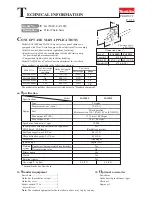
13 ENGLISH
Adjusting positive stops
►
Fig.9:
1.
90°Adjusting screw
2.
45°Adjusting screw
►
Fig.10
The tool is equipped with positive stops at 90° and 45°
to the table surface. To check and adjust the positive
stops, proceed as follows:
Move the handwheel as far as possible by turning it.
Place a triangular rule on the table and check to see
if the saw blade is at 90° or 45° to the table surface. If
the saw blade is at an angle shown in Fig. A, turn the
adjusting screws clockwise; if it is at an angle shown in
Fig. B, turn the adjusting screws counterclockwise to
adjust the positive stops.
After adjusting the positive stops, set the saw blade at
90° to the table surface. Then adjust the arrow pointer
so that its right edge is aligned to the 0° graduation.
►
Fig.11:
1.
Arrow pointer
Switch action
►
Fig.12:
1.
Switch
CAUTION:
Before operation, make sure that
the tool is turned on and off.
To start the tool, press the ON ( I ) button.
To stop it, press the OFF ( O ) button.
Sub fence (rip fence)
►
Fig.13:
1.
Clamping screw
2.
Rip fence
3.
Sub
fence
4.
Rail
If the rip fence comes close to the saw blade, use the
sub fence to support the workpiece. Loosen the clamp
-
ing screw and slide the sub fence out of the rail. Attach
the sub fence as illustrated and tighten the clamping
screws.
When the rip fence is attached to the left side of the
saw blade, switch the sub fence position. Remove the
clamping screws, sub fence, and rail from the rip fence.
Loosely attach the rail on the right side of the rip fence
using the removed clamping screws. After that, attach
the sub fence and tighten the clamping screws.
►
Fig.14:
1.
Rip fence
2.
Sub fence
3.
Clamping
screw
4.
Rail
Sub table (R)
►
Fig.15:
1.
Lever
►
Fig.16:
1.
Sub table (R)
This tool is provided with the sub table (R) on the right
side of the main table. To use the sub table (R), raise
both levers on the front right side, pull out the table (R)
fully and then lower the levers to secure it.
When using the sub table (R ), locate the scale plate
on the sub table after loosening the screw on it with
a screwdriver so that it becomes successive with the
scale plate on the main table.
►
Fig.17:
1.
Scale plate
2.
Screw
Sub table (back)
Optional accessory
►
Fig.18:
1.
Sub table (back)
2.
Screw
To use the sub table (back), loosen the screws on the
left and right hand sides under the table and pull it out
backwards to the desired length. At the desired length,
tighten the screws securely.
NOTE:
When using the sub table (back) during use of
the rip fence, pull out the sub table (back) more than
50 mm so that it does not hit against the top end of
the rip fence.
Sub table (L)
Optional accessory
►
Fig.19:
1.
Screw
2.
Sub table (L)
Sub table (L) (optional accessory) can be installed on
the left side of the table to obtain wider space.
Anti-kickback pawls
WARNING:
Use the Antikickback pawls when-
ever possible during the through cutting opera-
tions.
This will help prevent the material from being
pushed forward into the operator during a kickback
situation which may result in serious personal injury.
►
Fig.20:
1.
Antikickback pawl
2.
Clamp
To remove the anti-kickback pawls from the tool, loosen
the clamp on the root of the antikickback pawls and
then pull them out. To install, perform the removal pro-
cedure in reverse.
ASSEMBLY
CAUTION:
Always be sure that the tool is
switched off and unplugged before carrying out
any work on the tool.
Installing or removing saw blade
CAUTION:
Always be sure that the tool is
switched off and unplugged before installing or
removing the saw blade.
CAUTION:
Use only the Makita wrench pro-
vided to install or remove the saw blade.
Failure
to do so may result in overtightening or insufficient
tightening of the hex bolt. This could cause an injury.
CAUTION:
Use the following saw blade. Do
not use saw blades which do not comply with the
characteristics specified in these instructions.
Diameter
Blade thickness
Kerf
260 mm
Less than 1.9 mm
More than 2.1 mm














































